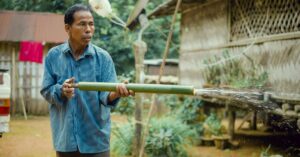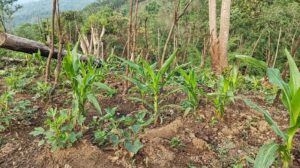The state of Meghalaya – home to the many Indigenous Peoples communities- is endowed with a rich diversity of fish. A variety of fish species are present in the water bodies of Meghalaya which range from small brooks, big rivers, and freshwater lakes. The latest study into the marine fauna of Meghalaya indicates that there are around 190 species of fish found in Meghalaya (Vaiphei and Gupta, 2016).
Indigenous fishing culture in Meghalaya
Although fish cannot be considered a staple part of the diet of the indigenous communities of Meghalaya, it still forms an important source of high-quality protein for the communities throughout different seasons. Owing to this, many of the communities have come up with various fishing practices and unique fishing gears that are still being used today.
An example can be made of the Khweng community in the Ri-Bhoi District of Meghalaya. In this community, before the commencement of the harvest season, water from the paddy field is drained and fishes are trapped at the drain outlet using a fishing gear called Khnam (in Khasi language). A Khnam is a conical-shaped bamboo basket equipped with a lid on top along with protrusions inside the basket to ensnare the fish.
Once the water level is low, fishes that aren’t trapped in the khnam are usually caught by employing a net-like equipment called Jasi, locally known as Tynsong in Khweng. The Tynsong features a round handle and a conical basket woven out of a vine called jyrmi. The technique of catching fish with the Tynsong involves manoeuvring of the fishing gear through shallow weed-filled ponds or fields, effectively entrapping fish.
While in the past, skilled women were responsible for weaving the net-like device with the jyrmi/vine, today, it has been replaced largely by synthetic plastic ropes.
The Kriah is another fishing device used by the community. Similar to the khnam, a kriah is made from long bamboo that is typically used in the morning or during heavy rainfall when water levels are high. The latter is used to trap larger varieties of fishes.
The community also fish from the rivers using similar fishing gears catching common varieties of fishes such as catfishes, puntius, and snakeheads among others which are found abundantly in the area.
Scope of fishery
For many of the populace of Meghalaya who have no access to water bodies for fishing, there is dependency on fisheries to meet their demands. As such, a number of bigger fish species are cultured and reared for commercial purposes in the state. Some of the common cultured fishes include Rohu (Labeo rohita), Catla (Catla catla), Mrigal (Cirrhinus mrigala), etc.
Apart from being a source of food, a wide variety of fishes from the state have been identified as potential aquarium fishes due to their diversified ornamental value like color, size and longevity. Small food fish such as Sind Danio (Devario devario), Swamp barb (Puntius chola), Golden dwarf barb (Pethia gelius), Queen loach (Botia Dario), Blue Perch (Badis badis) are some among many that can potentially be reared as ornamental fishes.
Home to endemic and world-famous aquatic lives
Of the 199 species of fish found in Meghalaya, 27 species were described from the State, going back to as early as the early 19th Century. Over the last decade, identification of many new species has also been carried out in the state with the standout being the identification of the world’s largest cave fish Neolissochilus pnar described in 2023 from the caves of Krem Um Ladaw and the adjacent Krem Chympe in Jaintia hills. The state is also an endemic home to 13 species of fishes.
Conservation efforts of Indigenous Communities
It is worth mentioning that indigenous communities continue to be in the forefront of conservation efforts from dangers posed by habitat destruction, overfishing, etc. To ensure the sustenance of fish populations for the generations to come, communities across the state impose certain regulations.
During the onset of summer monsoons when fishes usually spawn, catching of young fries and excessive fishing is prohibited. In any case where a fisherman catches excessive fishes, the smaller ones have to be put back in the water body in order to allow the fishes to grow.
The testimony of the indigenous community members from Umsawwar, including Mawdulop, Ksangrngi, Jatah Lakadong, Mawlong, and adjoining villages who protested against the damning of Umgnot River in 2021 stands out as one of the greatest examples of indigenous peoples fighting for their rights to their lands and stopping the habitat destruction of flora and fauna.
This story has been documented as part of the TNC-supported NESFAS’ project “Protection of forests in Meghalaya by adopting participatory, gender-centric, and equitable approaches”





